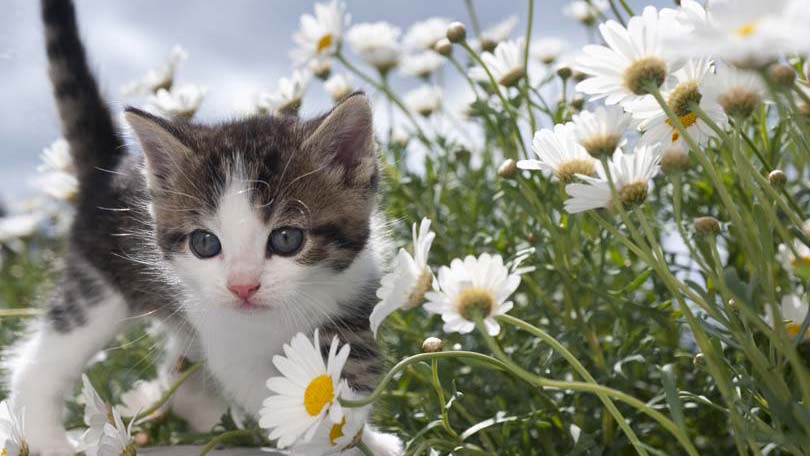
When Maryann Lee found her cat in a corner, body shaking with convulsions, she rushed her to the vet. After almost a week of being unsure whether her cat, Willy, would survive, she learned that, thankfully, her pet was going to make it. Had Willy died,
Maryann would have had to live with the fact that it was one of her household plants that had killed him.
Willy had chewed on the leaves of some of her plants. Maryann had no idea that her plants could hurt her pets, but she learned the hard way that they can. Precautionary measures could have stopped this from happening. Read below to learn what you can do to protect your cat.
Cat lovers know the joy that having a feline companion can bring. The soft purring as your pet rubs against your leg is enough to make the expenses and time to care for your pet well worth it. This includes removing harmful plants from your cat’s reach. The reason that it’s important to keep poisonous plants away from cats is probably obvious to anyone who has ever had a feline pet: Cats LOVE to snack on greenery! For this reason, houseplants often become an easy target for cats looking for something to munch on.
Sometimes this munching is harmless to the cat (although not to your plants!), but there are many plants that can seriously harm your cat if ingested. Knowing which plants are dangerous is important in order to keep your cat safe.
One common question is “why do cats eat plants?” There are a few reasons cats enjoy nibbling on your plants. Even wild cats, such as tigers and lions, eat grass. This supports the idea that greens are needed to supplement their fiber intake. Eating a large quantity can cause vomiting, so perhaps they eat plants when they need to rid themselves of a hairball. Some plants may simply taste good to cats. They may also find the crunchy texture enjoyable.
While you probably don’t enjoy seeing your indoor gardening efforts being reduced to shreds by your cats sharp little teeth, eating non-toxic plants is not harmful to your cat. Unfortunately, many plants ARE toxic, and the results of ingesting them can be deadly.
Because cats are such an important part of the family, it’s important that steps are taken to keep them safe and this includes learning which plants can be harmful to your pet.
Most cat owners know that it’s important to have yearly vet visits and vaccines, but fewer are aware of the dangers that may be lurking in the form of houseplants. Some of the most common houseplants can be deadly to cats. The list of harmful plants is long. While a list of plants that are poisonous to cats has been included in this article, it’s always best to check with your vet to be sure that all of the plants in your home are safe for your pet.
Some plants are dangerous in their entirety, while others are harmful only if certain parts of the plant, such as the leaves or seeds, are ingested. Below is a list of harmful plants. Of course, the safest bet is to exclude these plants from your home garden. If that’s not possible, they should be kept safely out of reach of your feline friends.
| Almond Aloe Vera Amaryllis Apple seeds Apricot (pits) Asparagus Autumn Crocus Avacado (fruit and pits) Azaleas Baby’s breath Baneberry Bayonet Beargrass Beech Belladonna Bird of Paradise Bittersweet Black Locust Black-eyed Susan Bleeding Heart Bloodroot Bluebonnet Boxwood Branching Ivy Buckeyes Buddhist Pine Burning Bush Buttercup Cactus Caladium Calla Lily Castor Bean Ceriman Charming Dieffenbachia Cherries Chinaberry Chinese Evergreen Christmas Rose Chrysanthemum Cineria Clematis Cordatum Coriaria Corn Plant Cornflower Cornstalk Corydalis Croton Crown of Thorns Cuban Laurel Cutleaf Cycads Cyclamen Daffodil Daphne Datura Deadly Nightshade Death Camas Decentrea Delphinium Devil’s Ivy Dracaena Dracaena Palm Dragon Tree |
Easter Lily Egglplant Elane Elderberry Elephant Ears Emerald Feather English Ivy Eucalyptus Evergren Eyonymus Ferns Figs (certain varieties) Flax Florida Beauty Fox Glove Geranium Giant Dumb Cane Glacier Ivy Golden Gold Dieffenbachia Gold Dust Dracaena Golden Glow Golden Pothos Gopher Purge Hearland Hemlock Henbane Holly Honeysuckle Horsebrush Hurricane plant Hyacinth Hydrangea Indian Rubber Plant Iris Ivy Jack in the Pulpit Janet Craig Japanese Show Lily Java Beans Jerusalem Cherry Jessamine Jimson Weed Jonquil Jungle Trumpets Kalanchoe Lacy Tree Lantana Larkspur Laurel Lily Lily of the Valley Lily Spider Locoweed Lupine Madagascar Dragon Marble Queen Marigold Marijuana Mescal Bean Mexican Breadfruit Miniature Croton Mistletoe Mock Orange Monkshood |
Moonseed Morning Glory Mother-in-Law’s Tongue Mountain Laurel Mushrooms Narcissus Needlepoint Ivy Nephytis Nightshade Oleander Onion Oriental Lily Peace Lily Peach (pits and leaves) Pencil Cactus Peony Periwinkle Philodendron Pimpernel Plumosa fern Poinciana Poinsetta Poison Oak Pokeweed Poppy Potato Precatory Bean Primrose Privet Red Emerald Red Princess Rhododendron Rhubarb Ribbon Plant Rosemary Pea Rubber Plant Saddle Leaf Sago Palm Satin Pothos Schefflera Scotch Broom Silver Pothos Skunk Cabbage Snow on the Mountain Snowdrops Spotted Dumb Cane Staggerweed Star of Bethlehem String of Pearls Sweetheart Ivy Sweetpea Tansy Mustard Taro Vine Tobacco Tomato Plant Tropic Snow Tulip Tung Tree Virginia Creeper Water Hemlock Weeping Fig Wild Call Wisteria Yews |
This list is not exhaustive, so when adding plants to your home it’s best to check with your vet to be sure that plant is safe to have around your pets. Should your cat eat a harmful plant, you should take him to the vet immediately. You can also call the Animal Poison Control Center for advice. The number is 1-888-426-4435, and there is a fee for using the service.
With the use of a little precaution, you’ll hopefully never have to use the Animal Poison Control Center hotline. Checking with your vet before adding new plants to your home may take an extra moment of your time, but it is well worth it if it helps to keep your beloved pet out of harms way.
